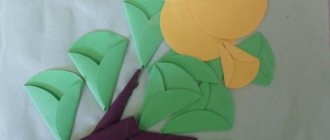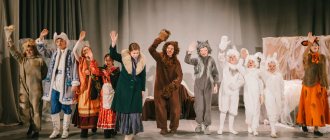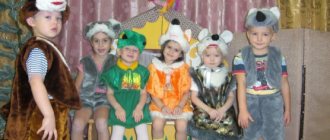Work program of the theatrical activities club in the 2nd junior group
March
1.I. "Granny's Fun"
II. "Let's bake pies"
To form a sustainable interest in oral folk art, to create a desire to listen to nursery rhymes, songs, to observe the actions of the teacher, to repeat the movements shown by the teacher.
“Granny”
for the teacher
2. “How I love my little cow”
II. “Girls and boys”
(dance to the text of the nursery rhyme)
Introduce children to the character of the puppet
theater
, support the desire to communicate with the toy, develop emotional responsiveness, a sense of rhythm. Cow toy
(bibabo)
3.I. "The sun is shining through the window"
II. “Sunshine and Rain”
(adventure game)
Encourage children to sing along with individual words of the song, accompanying the singing with movements, to create a joyful mood. Attributes for the outdoor game
“Sunshine and Rain”
4.I. "Zayushkina's hut"
II. “Three Merry Brothers”
(German folk song with movements)
Encourage children to carefully follow the development of action in a fairy tale, create a desire to sing along with individual words of the song, watching the action of the teacher with a toy Tabletop
theater
April
1.I. "Our ducks in the morning"
II. “Topotushki”
(a nursery rhyme)
Continue to introduce children to
the theater
, create a desire to take part in the performance, repeating the actors’ remarks after the teacher. Develop the perception of music through movements Mask hats for dramatization
2.I. "The Snow Maiden and the Fox"
II. “Stepan walked through the forest...”
(round dance)
Continue to introduce children to puppetry techniques, develop the ability to empathize with fairy tale characters, encourage children’s desire to participate in games with musical accompaniment. Flannelograph
3.I. "Masha is having lunch"
II. “Vasya the little goose ”
(folk game)
Continue to introduce children to puppeteering techniques, develop children’s speech, achieving clear pronunciation, and expand their vocabulary.
Improve children's motor activity in games with poetic accompaniment Toy Theater
4.I. “A beautiful hen lived with me”
.
II. “The chicken went out for a walk”
(dramatization of the song)
Encourage children’s desire to participate in creating a playful image with the help of movements, improve the motor activity of children Chicken toy, chicken hats.
May
1. “Who said meow?”
. Suteev. Teach children to perceive the content of a fairy tale,
carefully follow the development of the plot, imitate the voices of the Flannelograph characters.
2. "The Tale of the Stupid Mouse"
.
S. Ya. Marshak Introduce children to the new theater
, teach to listen carefully to the work, observing the actions of the teacher.
Table theater on mugs
.
3. "About shoes"
. 4. “Who came to visit us?” Involve children in participating in the play, teach them to imitate the movements of animals, distinguish sounds by pitch, rhythm (a bear walks, a hare jumps, a fox runs) Tambourines. Three different hats: bear, fox. hare)
Rainbow-talents.RF
Author: Bugrim Lyubov Vyacheslavovna
Teacher of preschool educational institution No. 5 "Joy" in the city of Dubna, Moscow region
Long-term planning of theatrical activities in the second junior group.
Bugrim L.V.
Long-term planning for theatrical activities in
second younger group.
September
Name:
1
.Acquaintance with the theater.
Fairy tale "Ryaba Hen"
Tasks :
Arouse interest in theatrical activities; develop the emotional and sensory sphere of children, encouraging them to express their feelings and communicate; learn to listen attentively to a poetic text and correlate its meaning with expressive movements to music; activate speech.
Material and equipment:
Decoration of a Russian hut; theatrical dolls (grandmother, grandfather, egg, chicken,
mouse)
2Name:
Game-situation “Frogs in the swamp”
Tasks :
Develop children's imagination and dialogue skills. Learn to use expressive intonations, correlate the content of the plot with the show in dramatization.
Material and equipment:
The caps will frog; pictures for a fairy tale on flannelgraph (big and small frogs, raven, heron
- Name:
Walk in the garden
Tasks :
Learn to move beautifully to calm music, making smooth movements; learn to feel muscle freedom and relaxation; encourage onomatopoeia to experiment with sounds
Material and equipment:
Autumn garden decoration; recorded bird music.
4Name:
Geese lived with grandma
Tasks :
Give children a positive charge of emotions, teach them to follow the progress of the plot depicted by an adult, and involve them in a conversation based on its content.
Material and equipment:
Table screen, glove puppets (geese), grandma costume.
October
5.Name:
Game-situation “Wet paths”
Tasks :
Learn to distinguish the intonations of music, cultivate a sense of harmony; encourage motor improvisation; learn to express your emotions through movement.
Material and equipment:
Umbrella, plumes.
6.Name:
Fairy tale "Spikelet"
Tasks :
Give an idea of the grain harvest; introduce the fairy tale “Spikelet”; evaluate the moral actions and behavior of the characters (the cockerel loves to work, the little mice are lazy, disobedient); introduce puppet theater (bibabo); activate speech.
Material and equipment:
Screen; bibabo dolls (two mice, a cockerel) and decorations; attributes (a bag of grain, a pot with a frog tied to the lid, wooden
spoons)
6.Name:
Game-situation “Which of us is a vegetable..”
Tasks :
Enrich children's emotions, involve them in improvisation; learn to discuss the content of a fairy tale.
Material and equipment:
Vegetables (tomato, cabbage, cucumber)
6.Name:
Fairy tale "Turnip"
Tasks :
Give an idea of the vegetable harvest; encourage children to express images of heroes in movement, facial expressions, and emotions; learn to improvise; teach coordination of movements; give a charge of positive emotions.
Material and equipment:
Character hats (turnip, grandfather, grandmother, granddaughter, dog, cat, mouse)
November
7.Name:
To grandma's village
Tasks :
Involve children in the game plot; activate auditory perception; encourage motor and intonation imitation; improvise within a given situation; learn to act with imaginary objects.
Material and equipment:
Scenery of rural life: house, grandmothers, chicken coop, and its inhabitants (toys: cockerel, hen, chickens); vegetable garden (beds with herbs and vegetables)
cabbage soup); goat toy, puppy toy.
8.Name
Game-situation “In a toy store”
Tasks :
Involve children in a role-playing game situation; teach to interact with toys and with each other as partners encourage acceptance
roles.
Material and equipment:
Toys: balls, cars, dolls, hare, bear, etc.
9.Name
Kolobok
Tasks :
to cultivate a friendly attitude towards each other, to develop children’s communication abilities, creative initiative, fantasy, imagination, improvisational skills, to instill in children a joyful emotional mood, intonation expressiveness of speech, articulatory apparatus, to instill curiosity about nature.
Equipment:
trees, oven, bushes with raspberries,
mushrooms, table, napkins, dishes, bench, tree stump, costumes for the play.
10.Name
Game-situation “First Ice”
Tasks :
Encourage children to solve problems; develop imagination; learn to express yourself in an individual group role.
Equipment:
A toy cat, a stove, a pot of porridge, a dish of gingerbread.
December
11.Name
Game-situation “Frosty days”
Tasks :
Give an emotional charge of vivacity, the joy of perceiving the coming winter; involve in a game situation, encourage improvisation.
Equipment:
Doll Dasha in winter clothes
12.Name
Fairy tale "Teremok"
Tasks :
Learn to express emotions through movement and facial expressions; introduce the fairy tale “Teremok”; encourage active perception of the tale; teach carefully, listen to the fairy tale to the end and follow the development of the plot; activate your vocabulary.
Equipment:
Screen - mouse hole; theatrical puppets (mouse, frog, fox, hare, wolf, bear) and decorations for a fairy tale (teremok)
12.Name
Fairy tale "The Wolf and the Little Goats".
Tasks :
To give an idea of the paraphernalia of the theater (poster, auditorium, tickets), to teach the rules of behavior in the theater; learn to tune in to perception
fairy tales from the first sounds of the musical introduction
Equipment:
Screen; dolls (goat, seven kids, wolf); decorations (backdrop “Forest and Village”, goat’s house, bush) and attributes (basket for the goat).
12.Name
Game situation "New Year's performance"
Tasks :
Please the children and create a pre-holiday atmosphere; introduce children to the tradition of celebrating the New Year; encourage use
familiar artistic material, to independence in role-playing games.
Equipment:
Room decorated for the New Year; equipment for displaying fairy tales on flannelgraph; toys and costume elements for dancing and singing.
January
12.Name
Game situation “Tales of Mother Blizzard”
Tasks :
Involve children in a game situation in motor improvisation, encourage them to enter into dialogue; carefully teach a new fairy tale and
monitor the development of its content.
Equipment:
Two snowflakes, a blizzard costume (cape and hat); equipment for a fairy tale on a flannelgraph, pictures: in the summer the sparrow Yashka pecks midges, sitting on a tree-
ve; a unkempt, hungry sparrow sits on a birch tree; grandfather and boy hang feeders on a birch tree; the sparrow Yashka watches the birds peck at food; Yashka and other sparrows are pecking at food.
12.Name
Fairy tale "Bragging Hare"
Tasks :
Make children happy; evoke an emotional response to the game; involve in the performance of a song; introduce the fairy tale “The Boasting Hare”; learn
listen carefully to the story.
Equipment:
Musical recordings (for the compositions “Winter Forest”, “Father Frost”, for the fairy tale “Bragging Hare”); scenery for the fairy tale “The Boasting Hare” (backdrop “Forest and Village”, birch).
12.Name
In the footsteps of a fairy tale
Tasks :
Encourage imaginative embodiment of the role; learn to move expressively; give an intonation-figurative idea of the fairy tale “The Boasting Hare”;
teach expressive facial expressions and movements in sketch games.
Equipment:
Scenery of a snowy meadow; rabbit hats for outdoor play; a book with the fairy tale “Bragging Hare”, adapted by A. Tolstoy.
February
12.Name
Game-situation “Cat on the stove song”
Tasks :
Introduce children to Russian folklore; teach dramatization; interact with each other in the game story.
Equipment:
Decoration of a Russian hut (mats, broom, stove, cast iron, grip, table, samovar, cups, benches); folk costumes; tea setting; toy cat
12.Name
Happy holiday defenders!
Tasks :
Talk about the army; show soldiers as protectors; involve in role play; learn to move rhythmically in accordance with the rhythm of poetry and music; practice onomatopoeia; learn to follow the rules.
Equipment:
Toy soldiers; costumes (sailors, tank crews, pilots); musical recordings (March of the Wooden Soldiers" by P.I. Tchaikovsky, recordings for the exit of a sailor, tankman, pilot).
12.Name
Game-situation “Varya came to the theater”
Tasks :
Encourage children to play out the plot; include in improvisation; accustom to independence in arranging the game. Improvise based on the plot of the fairy tale “The Three Little Pigs”
Equipment and attributes for the performance
Chairs, schematic decorations, costume elements, Varya doll.
12.Name
Game-situation “Fun Fair”
Tasks :
Involve children in dialogue; encourage one to take on a role; encourage each child in their chosen role. Introduce children to Russian folk traditions.
Equipment:
Attributes for the fair (goods), Russian folk costume for an adult (or its elements)
March
12.Name
Game-situation “Doll Katya is the birthday girl!”
Tasks :
Give an idea of how to behave at a birthday party; encourage children to be active and proactive; evoke positive emotions; promote improvisation; learn to engage in dialogue in the game.
Equipment:
Dolls; set toy table; substitute items.
12.Name
Cat and her kittens
Tasks :
Introduce the fairy tale “Cat and Kittens” and the theater on flannelgraph; develop empathy; teach carefully, listen to a fairy tale; learn to answer questions based on its content.
Equipment:
Flannelograph; pictures for the theater (kittens, cat, dog, booth, bowl of milk).
12.Name
Game-situation “Whose children?”
Tasks :
Involve children in an imaginary situation; encourage expressively, act in the role of animals.
Equipment:
hats pig dogs, dogs, cats.
12.Name
Fairy tale "The Fox and the Hare"
Tasks :
To introduce children to the origins of fiction (fairy tales), recognize good and evil, cultivate feelings of empathy, develop interest in theatrical
Equipment:
Envelope, two pictures depicting an ice house and a wooden house, a toy fox and a hare; wooden house, hats of a hare, fox, rooster, braid; activities, encourage creativity, desire to help.
April
12.Name
Game-situation “Zoo”
Tasks :
Introduce children to wild animals and their habits; cultivate love for all living things; develop curiosity; encourage to
entering the role.
Equipment:
Toys: monkey, tigers, elephants, etc.
12.Name
Game-situation “Magic pipe”
Tasks :
Encourage children to play drama; introduce a new fairy tale; intensify attention; teach to monitor the deployment of content
zhaniya fairy tales in the theater.
Equipment:
A pipe, doll birds, bird hats, pictures for a flannelgraph: a fox and a crane talking; a fox flies astride a crane; the fox falls;
the fox gets out of the haystack.
12.Name
"Okay, okay"
Tasks :
Introduce children to the Russian national tradition; practice finger gymnastics; learn to clearly pronounce words for fun
kah; include children in the game plot; evoke a positive emotional response to works of folklore; please the children.
Equipment:
Fox hat (for an adult); soft toy little fox; children's toy stove, saucepan, frying pan; bast shoes.
12.Name
Spring outside
Tasks :
Develop the emotional and sensory sphere of children: teach them to respond to sounds and intonations in music, listen to contrasting intonations in
speeches; encourage physical activity; demonstrate independence in choosing and playing a role; practice onomatopoeia.
Equipment:
Spring lawn scenery; vase with Flowers; hats of flowers for outdoor play; phonogram “Sounds of the forest”; musical recordings for the etude
and dances of birds and flowers.
May
12.Name
Game-situation “Sunshine, appear”
Tasks :
Develop emotional responsiveness to music; teach role-playing
incarnation; teach clear and expressive speech; please the child
Equipment:
Toys - bear, hedgehogs, fox, hare; sunshine, hats sunshine,
12.Name
Game-situation “Magic pipe”
Tasks :
introduce children to Russian folklore; include in the dramatization; learn to speak and act on behalf of the characters; intensify partnership interaction in the game.
Equipment:
Figures for performance.
12.Name
Fairy tale "Masha and the Bear"
Tasks :
Arouse children's imagination; develop memory; evoke associations;
teach to retell a fairy tale using objects (toys); learn
answer questions about the content of the fairy tale; develop the emotional side of children’s speech; create an emotionally positive mood for a fairy tale.
Equipment:
Table theater: the bear and the girl Mashenka.
12.Name
Game-situation “We will work
Tasks :
Make children happy; encourage physical activity; evoke positive emotions in a game on the theme of labor; involve in independent play out of the plot.
Equipment:
Broom, watering cans, buckets, dustpans; Masha doll.
12.Name
Go out to the green meadow
Tasks :
Make children happy; involve in the game; learn to act in a game as a group and
one by one; learn to move expressively to music in accordance
with text; awaken children's imagination; encourage physical activity.
Equipment:
Musical recordings (folk melodies, forest sounds); baskets; plumes, capes for streams.
Theater in the second junior group
Theatrical activities in kindergarten
Author: Filimonova Svetlana Grigorievna, teacher of the State Budgetary Educational Institution Secondary School No. 319, Moscow, preschool department. Description of the material : I offer material on conducting theater week in the 2nd junior group. This material will be useful to kindergarten teachers. I work in the 2nd junior group. Since the leading type of activity for children is play, an important role belongs to the puppet theater. It entertains and educates children, develops their imagination, teaches them to empathize with what is happening, creates an appropriate emotional mood, liberates the child, and increases his self-confidence. Children really love theatrical games, in which they can transform into their favorite characters, dramatize familiar fairy tales and admire theatrical performances performed by adults and older children. Therefore, I decided to take an active part in the theater week, which took place in our garden from March 24 to March 28 In 2014, theater week took place in our garden. Throughout the week, work was carried out to familiarize children with theatrical activities. At the first lesson, I told the children what theater is, how to behave in the theater. And for parents, I developed a reminder for the first trip to the theater with their children. Then, together with the teachers of another group, we staged the fairy tale “Kolobok” and showed it to the children.
During appliqué classes with children, we made a cut-out appliqué based on the fairy tale: “Turnip.” At home, the children and their parents made little books based on Russian folk tales.
And throughout the week I made different types of theaters (finger theater from papier-mâché, theater from CDs, shadow theater, theater on clothespins, rag dolls, theater from wooden shovels), and the children watched and helped as much as possible. I also made a card index of theatrical games and physical education lessons. In our corner there are several types of theater made with your own hands: All this is very easy to do, beautiful and the children are delighted. They really like to play. And at the end of the week we had a theater corner competition. Our theater took 1st place.
We recommend watching:
Theatrical activity in kindergarten DIY hat. Master class with step-by-step photos Scenario of a theatrical performance for children with disabilities (CP) Theatrical entertainment in the middle group. Scenario
Similar articles:
Dramatization of Chukovsky's fairy tale The Fly Tsokotukha for children 5-7 years old
Dramatization of a fairy tale in the senior group “About the Little Mouse”
Theater performance in the senior group. Fox-sister and gray wolf
Theater quiz for the senior group
Game performance in kindergarten. Middle - senior group




